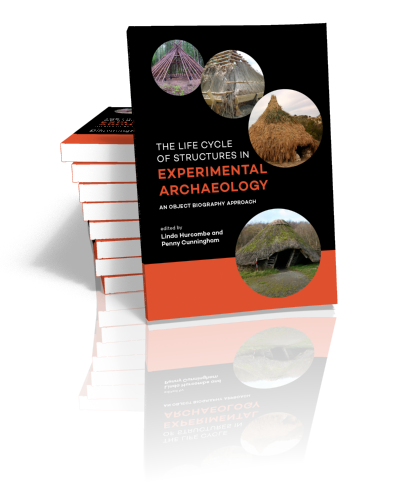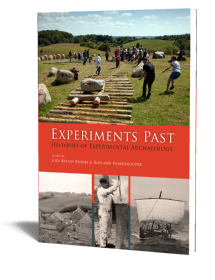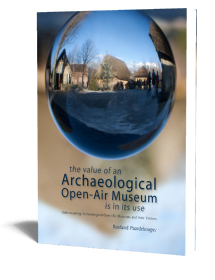The life cycle of structures in experimental archaeology
An object biography approach
Edited by Linda Hurcombe & Penny Cunningham | 2016

The life cycle of structures in experimental archaeology
An object biography approach
Edited by Linda Hurcombe & Penny Cunningham | 2016
Paperback ISBN: 9789088903656 | Hardback ISBN: 9789088903892 | Imprint: Sidestone Press | Format: 182x257mm | 230 pp. | Language: English | 8 illus. (bw) | 82 illus. (fc) | Keywords: archaeology, experimental archaeology, museology, Archaeological Open-Air Museums | download cover
Read online or downloaded 3192 times
-
Digital & Online access
This is a full Open Access publication, click below to buy in print, browse, or download for free.
-
Buy via Sidestone (EU & UK)
-
Buy via our Distributors (WORLD)
For non-EU or UK destinations you can buy our books via our international distributors. Although prices may vary this will ensure speedy delivery and reduction in shipping costs or import tax. But you can also order with us directly via the module above.
UK international distributor
USA international distributor
-
Bookinfo
Paperback ISBN: 9789088903656 | Hardback ISBN: 9789088903892 | Imprint: Sidestone Press | Format: 182x257mm | 230 pp. | Language: English | 8 illus. (bw) | 82 illus. (fc) | Keywords: archaeology, experimental archaeology, museology, Archaeological Open-Air Museums | download cover
Read online or downloaded 3192 times

We will plant a tree for each order containing a paperback or hardback book via OneTreePlanted.org.
The focus of Archaeological Open-Air Museums (AOAMs) is to present both the tangible and intangible past to the public. The tangible parts of AOAMs are the archaeological remains and the reconstructions. The intangible and, in some respects the most interesting part of an AOAM, is the story of the people the museum represents. This volume explores the research and visitor agendas of structures and their life cycles as they are experienced by experimental archaeology projects and AOAMs. The papers presented include research undertaken by both academics and craft specialists and demonstrate the value of experiential and experimental research to enhance both the visitor experience and research agendas. The papers were brought together as part of the OpenArch Project’s Dialogue with Science Work Package. OpenArch is a five year project with eleven international partners funded with support from the European Commission.
Structures include houses, boats, forges, and other diverse constructions. The structures are not static entities but change through time going through a life cycle. Key themes are the birth, life and death of structures. To explore these key themes papers in this volume consider the planning phase, the assembling of materials, the construction period and then the maintenance and repair needs and the change of use of structures as they age. For some structures this also includes issues surrounding decay, dilapidation, dismantling and destruction of these experimental structures. Understanding of these biographies not only contribute to our understanding of the archaeological record they also enable a consideration of the intangible aspects of structures whilst enhancing the visitor experience.
Preface
Penny Cunningham, Linda Hurcombe, and Leena Lehtinen
Introduction: The object biography approach to structures
Linda Hurcombe & Penny Cunningham
Planning Structures
Hands on Heritage: experimental and experiential archaeology in the Avalon Marshes, Somerset, UK.
Richard Brunning
“U Pagghiaru”: studies of traditional shepherd’s huts and their relevance to a Bronze Age hut-rebuilding project in Sicily
Kati Caruso and Claudia Speciale
Thinking through structures
Plant materials, hides and skins as structural components: perishable material culture and archaeological invisibility
Linda Hurcombe and Theresa Emmerich Kamper
Saving it for later: gathering, processing and food storage structures
Penny Cunningham
Boats as structures
Linda Hurcombe & Brian Cumby
Experiments on possible Stone Age glue types
Werner Pfeifer and Marco Claußen
Construction
Experiences of thatching at Kierikki Stone Age Village, Finland
Inga Nieminen
A gateway to the Bronze Age: Experimenting with woodworking methods of the Terramara culture in Montale in Italy
Wolfgang Lobisser
“From Earth I Rose” Experimenting stone slab furnaces of the Finnish Early Iron Age
Joni-Pekka Karjalainen and Juuso Vattulainen
Polvus eris et in polvus reverteris: Experimental production of Iberian iron and post-processing approach to the furnace structures
José Miguel Gallego Cañamero, Manel Gómez Gutiérrez and Josep Pou I Vallès
Structures
‘Huize Horsterwold’, the reconstruction of a Neolithic houseplan using Stone Age equipment
Annelou van Gijn and Diederik Pomstra
Testing the indoor environment and personal health in an inhabited reconstructed Viking Age house during winter
Jannie Marie Christensen
Experiences concerning Stone age building constructions in Finland
Eero Muurimäki
Decline of structures
Blackhand Kiva: biography of a replica ancestral Pueblo subterranean masonry-lined structure, Montezuma County, Colorado, USA
Bruce Bradley
The day the house sat down: the deterioration and collapse of the Ferrycarrig roundhouses
Tríona Sørensen
Dr. Linda Hurcombe
Linda Hurcombe is a leading figure in experimental archaeology and set up the distinctive MA in Experimental Archaeology programme at the University of Exeter where she has served as Head of the Department of Archaeology.
Dr. Penny Cunningham
Penny Cunningham is currently an Honorary Research Fellow within the Department of Archaeology at the University of Exeter. After completing a MA in Experimental Archaeology she went on to complete a PhD at the University of Exeter. Penny used experiments as a major methodological approach in her PhD thesis Food for thought: the exploitation of nuts in prehistoric Europe.
Abstract:
The focus of Archaeological Open-Air Museums (AOAMs) is to present both the tangible and intangible past to the public. The tangible parts of AOAMs are the archaeological remains and the reconstructions. The intangible and, in some respects the most interesting part of an AOAM, is the story of the people the museum represents. This volume explores the research and visitor agendas of structures and their life cycles as they are experienced by experimental archaeology projects and AOAMs. The papers presented include research undertaken by both academics and craft specialists and demonstrate the value of experiential and experimental research to enhance both the visitor experience and research agendas. The papers were brought together as part of the OpenArch Project’s Dialogue with Science Work Package. OpenArch is a five year project with eleven international partners funded with support from the European Commission.
Structures include houses, boats, forges, and other diverse constructions. The structures are not static entities but change through time going through a life cycle. Key themes are the birth, life and death of structures. To explore these key themes papers in this volume consider the planning phase, the assembling of materials, the construction period and then the maintenance and repair needs and the change of use of structures as they age. For some structures this also includes issues surrounding decay, dilapidation, dismantling and destruction of these experimental structures. Understanding of these biographies not only contribute to our understanding of the archaeological record they also enable a consideration of the intangible aspects of structures whilst enhancing the visitor experience.
Contents
Preface
Penny Cunningham, Linda Hurcombe, and Leena Lehtinen
Introduction: The object biography approach to structures
Linda Hurcombe & Penny Cunningham
Planning Structures
Hands on Heritage: experimental and experiential archaeology in the Avalon Marshes, Somerset, UK.
Richard Brunning
“U Pagghiaru”: studies of traditional shepherd’s huts and their relevance to a Bronze Age hut-rebuilding project in Sicily
Kati Caruso and Claudia Speciale
Thinking through structures
Plant materials, hides and skins as structural components: perishable material culture and archaeological invisibility
Linda Hurcombe and Theresa Emmerich Kamper
Saving it for later: gathering, processing and food storage structures
Penny Cunningham
Boats as structures
Linda Hurcombe & Brian Cumby
Experiments on possible Stone Age glue types
Werner Pfeifer and Marco Claußen
Construction
Experiences of thatching at Kierikki Stone Age Village, Finland
Inga Nieminen
A gateway to the Bronze Age: Experimenting with woodworking methods of the Terramara culture in Montale in Italy
Wolfgang Lobisser
“From Earth I Rose” Experimenting stone slab furnaces of the Finnish Early Iron Age
Joni-Pekka Karjalainen and Juuso Vattulainen
Polvus eris et in polvus reverteris: Experimental production of Iberian iron and post-processing approach to the furnace structures
José Miguel Gallego Cañamero, Manel Gómez Gutiérrez and Josep Pou I Vallès
Structures
‘Huize Horsterwold’, the reconstruction of a Neolithic houseplan using Stone Age equipment
Annelou van Gijn and Diederik Pomstra
Testing the indoor environment and personal health in an inhabited reconstructed Viking Age house during winter
Jannie Marie Christensen
Experiences concerning Stone age building constructions in Finland
Eero Muurimäki
Decline of structures
Blackhand Kiva: biography of a replica ancestral Pueblo subterranean masonry-lined structure, Montezuma County, Colorado, USA
Bruce Bradley
The day the house sat down: the deterioration and collapse of the Ferrycarrig roundhouses
Tríona Sørensen
Dr. Linda Hurcombe
Linda Hurcombe is a leading figure in experimental archaeology and set up the distinctive MA in Experimental Archaeology programme at the University of Exeter where she has served as Head of the Department of Archaeology.
Dr. Penny Cunningham
Penny Cunningham is currently an Honorary Research Fellow within the Department of Archaeology at the University of Exeter. After completing a MA in Experimental Archaeology she went on to complete a PhD at the University of Exeter. Penny used experiments as a major methodological approach in her PhD thesis Food for thought: the exploitation of nuts in prehistoric Europe.
-
Digital & Online access
This is a full Open Access publication, click below to buy in print, browse, or download for free.
-
Buy via Sidestone (EU & UK)
-
Buy via our Distributors (WORLD)
For non-EU or UK destinations you can buy our books via our international distributors. Although prices may vary this will ensure speedy delivery and reduction in shipping costs or import tax. But you can also order with us directly via the module above.
UK international distributor
USA international distributor
- Browse all books by subject
-
Search all books

We will plant a tree for each order containing a paperback or hardback book via OneTreePlanted.org.
You might also like:
© 2025 Sidestone Press KvK nr. 28114891 Privacy policy Sidestone Newsletter Terms and Conditions (Dutch)







